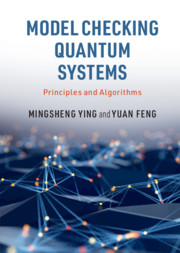Refine search
Actions for selected content:
5913 results in Programming Languages and Applied Logic
3 - Basics of Quantum Theory
-
- Book:
- Model Checking Quantum Systems
- Published online:
- 14 January 2021
- Print publication:
- 04 February 2021, pp 31-49
-
- Chapter
- Export citation
Contents
-
- Book:
- Model Checking Quantum Systems
- Published online:
- 14 January 2021
- Print publication:
- 04 February 2021, pp v-viii
-
- Chapter
- Export citation
Appendix 1 - Proofs of Technical Lemmas in Chapter 4
-
- Book:
- Model Checking Quantum Systems
- Published online:
- 14 January 2021
- Print publication:
- 04 February 2021, pp 181-189
-
- Chapter
- Export citation
6 - Model Checking Super-Operator-Valued Markov Chains
-
- Book:
- Model Checking Quantum Systems
- Published online:
- 14 January 2021
- Print publication:
- 04 February 2021, pp 138-174
-
- Chapter
- Export citation
Appendix 3 - Proofs of Technical Lemmas in Chapter 6
-
- Book:
- Model Checking Quantum Systems
- Published online:
- 14 January 2021
- Print publication:
- 04 February 2021, pp 196-200
-
- Chapter
- Export citation
Preface
-
- Book:
- Model Checking Quantum Systems
- Published online:
- 14 January 2021
- Print publication:
- 04 February 2021, pp ix-x
-
- Chapter
- Export citation
7 - Conclusions and Prospects
-
- Book:
- Model Checking Quantum Systems
- Published online:
- 14 January 2021
- Print publication:
- 04 February 2021, pp 175-180
-
- Chapter
- Export citation
Acknowledgements
-
- Book:
- Model Checking Quantum Systems
- Published online:
- 14 January 2021
- Print publication:
- 04 February 2021, pp xi-xii
-
- Chapter
- Export citation
Appendix 2 - Proofs of Technical Lemmas in Chapter 5
-
- Book:
- Model Checking Quantum Systems
- Published online:
- 14 January 2021
- Print publication:
- 04 February 2021, pp 190-195
-
- Chapter
- Export citation
1 - Introduction
-
- Book:
- Model Checking Quantum Systems
- Published online:
- 14 January 2021
- Print publication:
- 04 February 2021, pp 1-5
-
- Chapter
- Export citation

Model Checking Quantum Systems
- Principles and Algorithms
-
- Published online:
- 14 January 2021
- Print publication:
- 04 February 2021
11 - A Dialogical Account of Proofs in Mathematical Practice
- from Part III - Deduction and Cognition
-
- Book:
- The Dialogical Roots of Deduction
- Published online:
- 10 December 2020
- Print publication:
- 17 December 2020, pp 205-233
-
- Chapter
- Export citation
Conclusions
- from Part III - Deduction and Cognition
-
- Book:
- The Dialogical Roots of Deduction
- Published online:
- 10 December 2020
- Print publication:
- 17 December 2020, pp 234-237
-
- Chapter
- Export citation
Figures
-
- Book:
- The Dialogical Roots of Deduction
- Published online:
- 10 December 2020
- Print publication:
- 17 December 2020, pp viii-viii
-
- Chapter
- Export citation
5 - Deduction in Mathematics and Dialectic in Ancient Greece
- from Part II - The History of Deduction
-
- Book:
- The Dialogical Roots of Deduction
- Published online:
- 10 December 2020
- Print publication:
- 17 December 2020, pp 87-107
-
- Chapter
- Export citation
10 - The Phylogeny of Deductive Reasoning
- from Part III - Deduction and Cognition
-
- Book:
- The Dialogical Roots of Deduction
- Published online:
- 10 December 2020
- Print publication:
- 17 December 2020, pp 187-204
-
- Chapter
- Export citation
6 - Aristotle’s Syllogistic and Other Ancient Logical Traditions
- from Part II - The History of Deduction
-
- Book:
- The Dialogical Roots of Deduction
- Published online:
- 10 December 2020
- Print publication:
- 17 December 2020, pp 108-130
-
- Chapter
- Export citation
1 - The Trouble with Deduction
- from Part I - The Philosophy of Deduction
-
- Book:
- The Dialogical Roots of Deduction
- Published online:
- 10 December 2020
- Print publication:
- 17 December 2020, pp 3-21
-
- Chapter
- Export citation
3 - The Prover–Skeptic Dialogues
- from Part I - The Philosophy of Deduction
-
- Book:
- The Dialogical Roots of Deduction
- Published online:
- 10 December 2020
- Print publication:
- 17 December 2020, pp 37-60
-
- Chapter
- Export citation
Index
-
- Book:
- The Dialogical Roots of Deduction
- Published online:
- 10 December 2020
- Print publication:
- 17 December 2020, pp 261-272
-
- Chapter
- Export citation
